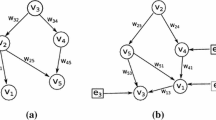Abstract
Causal graphs provide a key tool for optimizing the validity of causal effect estimates. Although a large literature exists on the mathematical theory underlying the use of causal graphs, less literature exists to aid applied researchers in understanding how best to develop and use causal graphs in their research projects. We sought to understand why researchers do or do not regularly use DAGs by surveying practicing epidemiologists and medical researchers on their knowledge, level of interest, attitudes, and practices towards the use of causal graphs in applied epidemiology and health research. We used Twitter and the Society for Epidemiologic Research to disseminate the survey. Overall, a majority of participants reported being comfortable with using causal graphs and reported using them ‘sometimes’, ‘often’, or ‘always’ in their research. Having received training appeared to improve comprehension of the assumptions displayed in causal graphs. Many of the respondents who did not use causal graphs reported lack of knowledge as a barrier to using DAGs in their research. Causal graphs are of interest to epidemiologists and medical researchers, but there are several barriers to their uptake. Additional training and clearer guidance are needed. In addition, methodological developments regarding visualization of effect measure modification and interaction on causal graphs is needed.



Similar content being viewed by others
Availability of data and material
The full survey used to obtain these results is included in the supplementary material.
References
Greenland S, Pearl J, Robins JM. Causal diagrams for epidemiologic research. Epidemiology. 1999;10:37–48 (PMID: 9888278).
Tennant PW, Harrison WJ, Murray EJ, Arnold KF, Berrie L, Fox MP, et al. Use of directed acyclic graphs (DAGs) in applied health research: Review and recommendations. medRxiv [working paper]. 2020;
Hernan MA, Robins JM. Causal Inference: What If. Boca Raton: Chapman & Hill/CRC; 2020.
Pearl J. Causal diagrams for empirical research. Biometrika. 1995;82:669–88. https://doi.org/10.2307/2337329.
Pearl J, Glymour M, Jewell NP. Causal Inference in Statistics: A Primer. UK: Wiley; 2016.
Glaser B. The discovery of grounded theory: strategies for qualitative research. Chicago: Aldine Publishing Company; 1967.
Strauss A. Basics of qualitative research: grounded theory procedures and techniques. Newbury Park, CA: SAGE Publications; 2013.
Straus A, Corbin JM. Grounded theory in practice. Sage; 1997.
Richardson TS, Robins JM. Single World Intervention Graphs (SWIGs): A unification of the counterfactual and graphical approaches to causality. University of Washington Center for Statistics and the Social Sciences [Working Paper] 2013.
Robins J, Richardson T. Alternative graphical causal models and the identification of direct effects. In: Robins JM, Richardson TS, editors. To appear in causality and pschyopathology: finding the determinants of disorders and their cures. Oxford University Press; 2010.
Robins J. A new approach to causal inference in mortality studies with a sustained exposure period-application to control of the healthy worker survivor effect. Math Model. 1986;7:1393–512. https://doi.org/10.1016/0270-0255(86)90088-6.
VanderWeele TJ, Robins JM. Four types of effect modification: a classification based on directed acyclic graphs. Epidemiology. 2007;18:561–8.
Weinberg CR. Can DAGs clarify effect modification? Epidemiology. 2007;18:569–72.
Textor J, van der Zander B, Gilthorpe MK, Liskiewicz M, Ellison GTH. Roboust causal inference using directed acyclic graphs: the R package “dagitty.” Int J Epidemiol. 2016;45:1887–94.
Schisterman EF, Swanson CW, Lu YL, Mumford SL. The changing face of epidemiology: gender disparities in citations? Epidemiology. 2017;28:159–68.
Acknowledgements
The authors would like to thank the survey participants, the Society for Epidemiologic Research, and everyone on #epitwitter who helped spread the word about our survey.
Funding
EJM and RBM were partly funded by the Eunice Kennedy Shriver National Institute of Child Health and Human Development (NICHD) R21HD098733. JPD was supported by grant K12-HL138039 from the National Heart, Lung, and Blood Institute (National Institutes of Health, Bethesda, MD, USA). ECC was supported by grant K01HD100222 from the Eunice Kennedy Shriver National Institute of Child Health and Human Development (NICHD).
Author information
Authors and Affiliations
Contributions
In terms of author contributions for this paper; RBM and EJM conceived of the idea; RBM, EJM and EC designed the survey; and all authors approved the survey instrument and contributed to the manuscript writing.
Corresponding author
Ethics declarations
Conflict of interest
Authors state no conflict of interest.
Ethical approval
The survey was exempted by the Boston University School of Public Health Institutional Review Board. The surveys were completely anonymous and no IP addresses were collected.
Additional information
Publisher's Note
Springer Nature remains neutral with regard to jurisdictional claims in published maps and institutional affiliations.
Supplementary Information
Below is the link to the electronic supplementary material.
Rights and permissions
About this article
Cite this article
Barnard-Mayers, R., Childs, E., Corlin, L. et al. Assessing knowledge, attitudes, and practices towards causal directed acyclic graphs: a qualitative research project. Eur J Epidemiol 36, 659–667 (2021). https://doi.org/10.1007/s10654-021-00771-3
Received:
Accepted:
Published:
Issue Date:
DOI: https://doi.org/10.1007/s10654-021-00771-3




